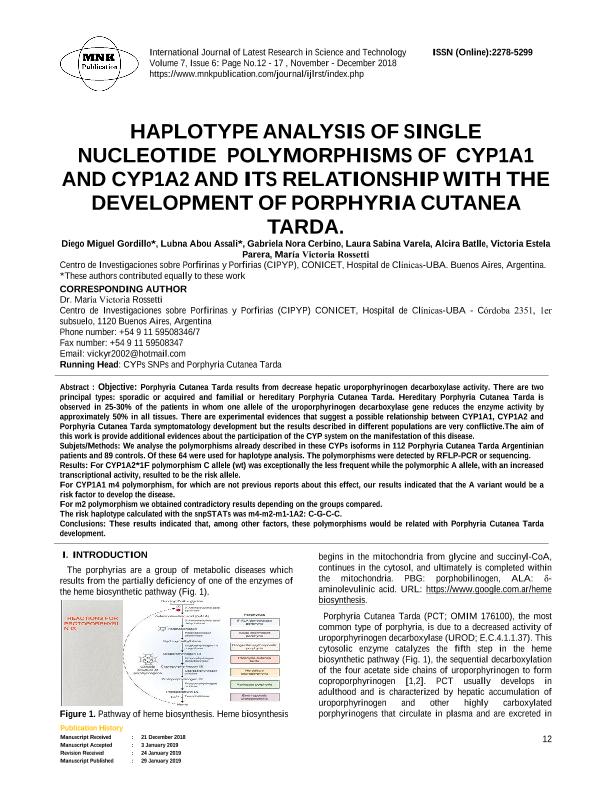Artículo
Haplotype analysis of single nucleotide polymorphisms of cyp1a1 and cyp1a2 and its relationship with the development of porphyria cutanea tarda
Gordillo, Diego Miguel ; Abou Assali, Lubna
; Abou Assali, Lubna ; Cerbino, Gabriela Nora
; Cerbino, Gabriela Nora ; Varela, Laura Sabina
; Varela, Laura Sabina ; Batlle, Alcira Maria del C.
; Batlle, Alcira Maria del C. ; Parera, Victoria Estela
; Parera, Victoria Estela ; Rossetti, Maria Victoria
; Rossetti, Maria Victoria
 ; Abou Assali, Lubna
; Abou Assali, Lubna ; Cerbino, Gabriela Nora
; Cerbino, Gabriela Nora ; Varela, Laura Sabina
; Varela, Laura Sabina ; Batlle, Alcira Maria del C.
; Batlle, Alcira Maria del C. ; Parera, Victoria Estela
; Parera, Victoria Estela ; Rossetti, Maria Victoria
; Rossetti, Maria Victoria
Fecha de publicación:
02/2019
Editorial:
MNK publication
Revista:
International Journal of Latest Research in Science and Technology
ISSN:
2278-5299
Idioma:
Inglés
Tipo de recurso:
Artículo publicado
Clasificación temática:
Resumen
Abstract : Objective: Porphyria Cutanea Tarda results from decrease hepatic uroporphyrinogen decarboxylase activity. There are twoprincipal types: sporadic or acquired and familial or hereditary Porphyria Cutanea Tarda. Hereditary Porphyria Cutanea Tarda is observed in 25-30% of the patients in whom one allele of the uroporphyrinogen decarboxylase gene reduces the enzyme activity by approximately 50% in all tissues. There are experimental evidences that suggest a possible relationship between CYP1A1, CYP1A2 andPorphyria Cutanea Tarda symptomatology development but the results described in dif erent populations are very conflictive.The aim ofthis work is provide additional evidences about the participation of the CYP system on the manifestation of this disease. Subjets/Methods: We analyse the polymorphisms already described in these CYPs isoforms in 112 Porphyria Cutanea Tarda Argentinianpatients and 89 controls. Of these 64 were used for haplotype analysis. The polymorphisms were detected by RFLP-PCR or sequencing. Results: For CYP1A2*1F polymorphism C allele (wt) was exceptionally the less frequent while the polymorphic A allele, with an increasedtranscriptional activity, resulted to be the risk allele. For CYP1A1 m4 polymorphism, for which are not previous reports about this effect, our results indicated that the A variant would be arisk factor to develop the disease. For m2 polymorphism we obtained contradictory results depending on the groups compared. The risk haplotype calculated with the snpSTATs was m4-m2-m1-1A2: C-G-C-C. Conclusions: These results indicated that, among other factors, these polymorphisms would be related with Porphyria Cutanea Tardadevelopment.
Archivos asociados
Licencia
Identificadores
Colecciones
Articulos(CIPYP)
Articulos de CENTRO DE INVEST. SOBRE PORFIRINAS Y PORFIRIAS
Articulos de CENTRO DE INVEST. SOBRE PORFIRINAS Y PORFIRIAS
Citación
Gordillo, Diego Miguel; Abou Assali, Lubna; Cerbino, Gabriela Nora; Varela, Laura Sabina; Batlle, Alcira Maria del C.; et al.; Haplotype analysis of single nucleotide polymorphisms of cyp1a1 and cyp1a2 and its relationship with the development of porphyria cutanea tarda; MNK publication; International Journal of Latest Research in Science and Technology; 7; 2-2019; 12-17
Compartir



